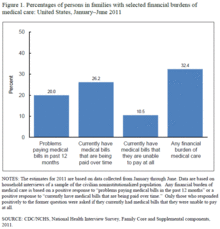Medical debt
Medical debt refers to debt incurred by individuals due to health care costs and related expenses.
Medical debt is different from other forms of debt, because it is usually incurred accidentally or faultlessly. People do not plan to fall ill or hurt themselves, and health care remedies are often unavoidable; medical debt is often treated with more sympathy than other kinds of debt resulting in advice that people ought not try to convert it to credit card debt.[1]
United States

Medical debt is an especially notable phenomenon in the United States. In less developed nations those on low income in need of treatment will often avail themselves of what ever help they can from either the state or NGOs without going into debt, and in most developed countries public coverage of healthcare costs are comprehensive. But in the USA, even when the patient has insurance coverage, including coverage under the Patient Protection and Affordable Care Act of 2010, considerable medical costs remain the patient's responsibility. Consequently, medical debt has been found by a 2009 study to be the primary cause of personal bankruptcy.[2][3]
A 2007 survey had found about 70 million Americans either have difficulty paying for medical treatment or have medical debt.[4] Studies have found people are most likely to accumulate large medical debts when they do not have health insurance to cover the costs of necessary medications, treatments, or procedures—in 2009 about 50 million Americans had no health coverage.[2] However, about 60% of those found to have medical debt were insured.[4] Health insurance plans rarely cover any and all health-related expenses; for insured people, the gap between insurance coverage and the affordability of health care manifests as medical debt. As with any type of debt, medical debt can lead to an array of personal and financial problems—including having to go without food and heat plus a reluctance to seek further medical treatment.[4][5] Aggressive debt collecting has been highlighted as an aggravating factor.[6] A study has found about 63% of adults with medical debt avoided further medical treatment, compared with only 19% of adults who had no such debt.[7]
According to a study conducted in 2012 by Demos that among indebted households 62% cited out-of-pocket medical expenses as a contribution to their debt.[8]
Treatment of Medical Debt under Chapter 7 bankruptcy In US
Medical debt is considered as a non-priority unsecured debt in Chapter 7 bankruptcy. In other words, medical debts won’t enjoy any priority in case the trustee is able to make any sort of repayments to the creditors. If a part of the medical debt is repaid through bankruptcy, then the remaining outstanding medical debt will be discharged under the same. [9]
See also
| Wikimedia Commons has media related to Private medical debt statistics. |
- Charge description master
- Health care in the United States
- Health economics
- Health insurance
- Underinsured
References
- ↑ Alderman, Lesley (June 5, 2009). "When Medical Bills Outpace Your Means, Seize Control Swiftly". The New York Times. Retrieved June 22, 2009.
- 1 2 "Medical Debt Huge Bankruptcy Culprit—Study: It's Behind Six-In-Ten Personal Filings". CBS News. June 5, 2009. Retrieved June 22, 2009.
- ↑ Himmelstein, David U.; Thorne, Deborah; Warren, Elizabeth; Woolhandler, Steffie (August 2009). "Medical Bankruptcy in the United States, 2007: Results of a National Study". The American Journal of Medicine. 122 (8): 741–746. doi:10.1016/j.amjmed.2009.04.012. ISSN 0002-9343. OCLC 1480156. PMID 19501347. See full text.
- 1 2 3 Heavey, Susan (August 20, 2008). "Consumers Face Rising Medical debt: Survey". Reuters. Retrieved June 22, 2009.
- ↑ Kalousova, Lucie; Burgard, Sarah A. (June 2013). "Debt and Foregone Medical Care". Journal of Health and Social Behavior. 54 (2): 204–20. doi:10.1177/0022146513483772. ISSN 2150-6000. OCLC 38543580. PMID 23620501.
- ↑ O'Teele, Thomas P.; Arbelaes, Jose J.; Lawrence, Robert S.; Baltimore Community Health Consortium (July 2004). "Medical Debt and Aggressive Debt Restitution Practices: Predatory Billing Among the Urban Poor". Journal of General Internal Medicine. 19 (7): 772–778. doi:10.1111/j.1525-1497.2004.30099.x. ISSN 1525-1497. OCLC 41390549. PMC 1492479
 . PMID 15209592.
. PMID 15209592. - ↑ Daly, Rich (October 21, 2005). "Working-Age Americans Bear Brunt of Medical Debt". Psychiatry Online. Retrieved June 22, 2009.
- ↑ "How Employment Credit Checks Keep Qualified Workers Out of a Job". Demos. Retrieved October 3, 2013.
- ↑ Bulkat, Baran. "Medical Debt in Chapter 7 Bankruptcy". Nolo. Retrieved April 26, 2016.
- Klozotsky, Michael (April 23, 2013). "Oklahoma Governor Signs Medical Debt Collection Bill". InsideARM.com.